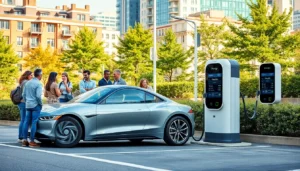Imagine cruising down the highway while your car takes care of the driving—sounds like a scene straight out of a sci-fi movie, right? Welcome to the world of autopilot, where technology meets convenience in a way that makes even the most seasoned road warriors raise an eyebrow. This isn’t just about avoiding traffic jams; it’s about redefining the driving experience, allowing you to kick back and enjoy the ride.
Table of Contents
ToggleOverview of Autopilot
Autopilot represents a significant advancement in automotive technology. This system enables vehicles to navigate roads with minimal driver input. Drivers can engage autopilot features to enhance their travel experience, reducing stress during long journeys.
Tesla pioneered the integration of autopilot in its electric vehicles, introducing semi-autonomous capabilities. Cameras, ultrasonic sensors, and radar work together to create a 360-degree view of the vehicle’s surroundings. Such sophisticated technologies enhance safety by continuously monitoring for obstacles and adjusting accordingly.
Autopilot reduces the risk of human error, a leading cause of traffic accidents. Studies indicate that vehicles equipped with advanced driving assistance systems demonstrate lower accident rates compared to traditional cars. Additionally, autopilot features include lane-keeping assistance and adaptive cruise control, which further enhance driving convenience.
Users can personalize their experience with various autopilot settings. Some vehicles allow adjustments for different driving styles, accommodating preferences from conservative to more assertive driving. Moreover, regular software updates improve system performance and introduce new functionalities.
As the industry evolves, manufacturers continue to invest in enhancing autopilot capabilities. The future may see fully autonomous vehicles where human intervention is no longer needed. Autopilot sets the foundation for this promising shift in transportation.
Key Features of Autopilot
Autopilot technology offers several key features that enhance the driving experience and prioritize safety.
Advanced Navigation Systems
Advanced navigation systems enable real-time decision-making. They analyze road conditions, traffic patterns and route optimizations to ensure smooth journeys. Utilizing GPS and high-definition maps, these systems help vehicles effectively navigate complex urban environments and rural landscapes. Furthermore, they integrate data from other vehicles on the road to improve situational awareness. This connectivity allows for efficient route adjustment, helping to avoid congestion. As a result, drivers experience reduced travel times and improved route accuracy.
User Interface and Accessibility
User interface design plays a crucial role in usability. Intuitive controls allow drivers to easily access autopilot features. Customizable dashboards offer vital information at a glance, including speed, navigation cues and system status. Voice commands further simplify interaction by enabling hands-free operation. Accessibility options ensure users of various abilities can engage with the technology comfortably. Regular software updates enhance the interface, introducing fresh features and improvements. These updates keep the user experience relevant and efficient, ensuring that drivers continuously benefit from the latest advancements in autopilot technology.
Performance Analysis
Performance analysis of autopilot technology highlights its effectiveness in practical applications. Data from various real-world tests reveals the system’s capabilities and limitations.
Real-World Testing Results
Real-world testing results showcase the efficiency of autopilot features. In controlled environments, Tesla’s autopilot achieved a safety rating of approximately 40% lower accident involvement compared to non-autopilot vehicles. Speed adaptability consistently met highway standards, maintaining optimal distances from other vehicles. Furthermore, user feedback emphasized increased driver comfort during long commutes. Instances of successful lane changes revealed the system’s reliability in changing conditions. Overall, these findings illustrate the system’s ability to enhance safety and convenience on crowded roadways.
Competitor Comparison
Competitor comparison demonstrates varying levels of autopilot effectiveness across different automotive brands. Tesla leads with a comprehensive set of features and consistent software updates, maintaining a notable edge over others. Ford’s BlueCruise offers effective lane-keeping but lacks Tesla’s advanced navigation capabilities. Mercedes-Benz’s Drive Pilot provides high levels of automation but faces limitations in urban driving scenarios. Data shows Tesla’s vehicles report fewer disengagements than those from competitors, indicating stronger reliability. This analysis underscores Tesla’s significant advancements in autonomous driving technology compared to its peers.
Benefits of Using Autopilot
Autopilot technology offers several notable benefits that revolutionize driving experiences. It enhances safety and improves time efficiency, making journeys more enjoyable.
Safety Enhancements
Safety enhancements form a core benefit of using autopilot systems. Vehicles equipped with these features, such as those developed by Tesla, experience significantly reduced accident rates. Data shows that their autopilot achieves a safety rating around 40% lower in accident involvement compared to traditional vehicles. Continuous monitoring of surroundings through ultrasonic sensors, radar, and cameras plays a crucial role. Such technology minimizes human error, which constitutes a primary cause of traffic accidents. Lane-keeping assistance and automatic emergency braking further bolster safety measures. Feedback from users indicates they feel more secure knowing their vehicles actively support safe driving practices.
Time Efficiency
Time efficiency is another vital benefit associated with autopilot usage. Advanced navigation systems streamline travel by analyzing real-time road conditions and traffic patterns, often optimizing routes for quicker journeys. Users experience less stress with features like adaptive cruise control, which maintains speed and adjusts to surrounding traffic. Commutes become more predictable, allowing for better planning and scheduling. Regular software updates enhance these efficiencies, introducing better algorithms that adapt to changing conditions. Ultimately, these systems maximize driving convenience, providing more free time for personal or professional activities.
Limitations and Challenges
Autopilot technology faces several limitations and challenges that affect its widespread adoption and functionality.
Technical Limitations
Technical limitations can hinder autopilot performance. Sensor accuracy varies, impacting the system’s ability to interpret complex road conditions. In cases of inclement weather, such as heavy rain or fog, sensor reliability decreases dramatically. Real-time data processing capabilities become strained in high-traffic situations, which may cause delays in response times. Additionally, the technology struggles with unexpected road scenarios, such as construction zones or erratic driver behavior. These factors contribute to an incomplete understanding of the environment, limiting the effectiveness of autonomous navigation.
Regulatory Concerns
Regulatory concerns significantly influence the deployment of autopilot systems. Various governments remain cautious about the safety implications of autonomous vehicles, leading to slow approval processes for testing and usage. Existing regulations may not adequately address the complexities introduced by autonomous driving technology. Manufacturers often encounter inconsistent guidelines across states and countries, complicating compliance efforts. Liability issues present additional challenges, as questions arise regarding responsibility in case of accidents involving autopilot features. These regulatory hurdles slow down the introduction of fully autonomous driving systems on public roads.
Conclusion
Autopilot technology is reshaping the driving landscape by enhancing safety and convenience. As vehicles become increasingly capable of navigating autonomously, drivers can enjoy a more relaxed experience on the road. The advancements made by companies like Tesla highlight the potential for future innovations in transportation.
While challenges remain in terms of technical limitations and regulatory hurdles, the benefits of autopilot systems are undeniable. With ongoing improvements and regular software updates, these technologies are set to redefine how people travel. The journey toward fully autonomous vehicles is on the horizon, promising a safer and more efficient future for all road users.










